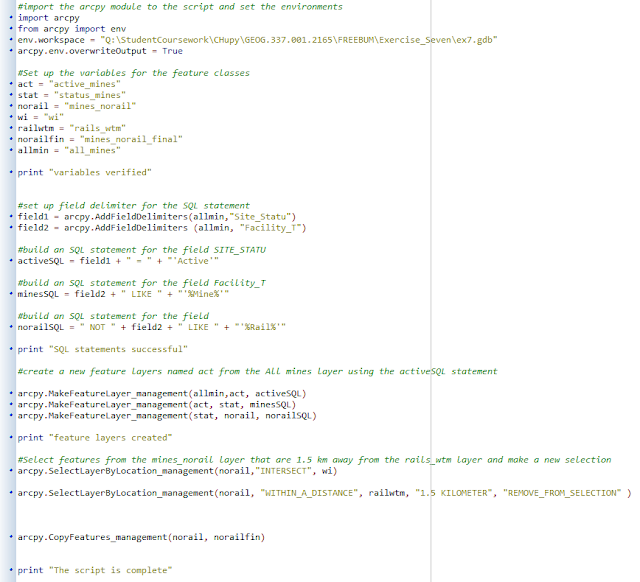Goals and Objectives:
Locating and downloading data from online needs to be carefully recorded and organized. The purpose of this lab was to become familiar with the process of downloading data from websites online and to create a py script to run different tools to display data for Trempealeau County, Wisconsin.
The final product of the lab was to display Sand Mining Suitability from the data we collected from the various web sources. Specifically, Elevation, Soil Survey, and Cropland data were used as criteria for this assessment.
 |
| Figure 1. A Sand Mining Suitablity Map for Trempealeau County, Wisconsin created using data from the USGS and USDA The map was created using ArcMap. |
Methods:
In the first part of the lab data was collected from USGS (United States Geological Survey), USDA (United States Department of Agriculture), and the MRLC (Multi-Resolution Land Characteristics Consortium).
USGS
(1/3-arc second DEM Elevation dataset for Trempealeau County)
(National Land Cover Database 2011)
Elevation and Land Cover data were collected from the USGS website using the National Map Viewer http://nationalmap.gov/about.html
From the National Map Viewer go to the National Map Viewer and Download Platform and then the TNM Download Client Link. After that it is necessary to zoom into the state of Wisconsin and find Trempealeau County. Data for Trempealeau County was selected by tracing a box around the entire county. Then, on the left side of screen the National Land Cover Data 2011 and Elevation Products (1/3-arc second DEM) were selected to download into a temporary folder. Both datasets were unzipped into a personal student folder for further use and named appropriately.
USDA
Cropland and Soil data were obtained through the USDA.
The cropland data was requested from...by entering in Trempealeau County, Wisconsin and selecting "Cropland Data Layer by State". A personal e-mail containing the desired cropland data was sent from the USDA website and the data could be downloaded from there into the temporary folder. Again, the data was unzipped into a personal student folder.
The soil dataset was gathered from http://websoilsurvey.sc.egov.usda.gov/App/HomePage.htm
From the panel on the left hand side of the screen under "Soil Survey Area" Trempealeau County, Wisconsin was chosen. The data was downloaded again to the temporary folder and unzipped into the personal student folder.
Trempealeau County Land Records Department
The Trempealeau County file geodatabase containing many relevant feature classes was also downloaded for this lab. The data was collected from:
http://www.tremplocounty.com/tchome/landrecords/
Trempealeau County Land Records Department
The Trempealeau County file geodatabase containing many relevant feature classes was also downloaded for this lab. The data was collected from:
http://www.tremplocounty.com/tchome/landrecords/
Data Accuracy
Scale
|
Effective Resolution
|
Min. Mapping Unit
|
Planimetric Coordinate Accuracy
|
Lineage
|
Temporal Accuracy
|
Attribute Accuracy
|
|
USDA Soil Survey Data
|
Couldn’t find
|
||||||
USDA Cropland
|
30 meter
|
Department of Agriculture, (NASS), Research and Development Division, Geospatial Information Branch, (SARS), Universal Transverse Mercator (UTM), North American Datum of 1983 or World Geodetic System 1984, Albers Conical Equal Area projection
|
Not found
|
||||
USGS Land Cover Data
|
30 meter
|
5-pixel
|
U.S. Geological Survey, purpose: to provide the nation with current land cover data, North American Datum of 1983 and Albers Conical Equal Area projection
|
Updated every 5 years
|
Has not been conducted: Unknown
|
||
USGS Elevation Data
|
10 meter
|
N/A
|
not found
|
U.S. Geological Survey, purpose: to produce foundational elevation data for earth science studies, North American Datum of 1983
|
Updated as new data is available
|
N/A
|
|
Trempealeau County Geodatabase
|
Trempealeau County Land Records Department,2007
|
Updated as needed
|
Conclusions
From reviewing the table it is obvious analysis of the metadata is crucial to understanding the data. The lack of information is concerning because this information helps in determining how the data can be used and manipulated without causing data integrity issues, For example, the scale, minimum mapping unit, resolution, and coordinate accuracy are important because in situations like this lab, where you may want to compare different rasters or even layer them on top of each other, the parameters can give an appropriate value to set the scale etc, The scale should be set to the smallest scale in order to accommodate the accuracy of all the features of the raster with the smallest scale.
Lineage is extremely important to keep track of for the purpose of knowing where the data came from and how it was collected. If there are any questions regarding the data, the source can be directly contacted and the discrepancy can be sorted out correctly, Also, it is necessary to cite the source in which your data originated, so it is crucial to know the source and cite it correctly.
From the table it is concerning that attribute accuracy is not an easy parameter to track down, because this sheds light on how well the attributes are representing the real world. Naturally, it is ideal to have the attributes matching the real world exactly, but depending on certain things this is not always the case, so that is why it is necessary to review the attribute accuracy.

